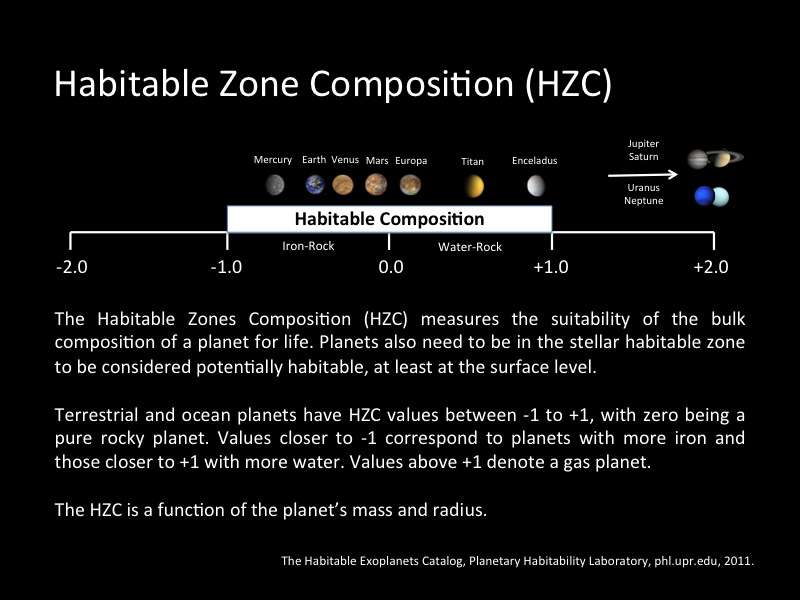It looks like you're using an Ad Blocker.
Please white-list or disable AboveTopSecret.com in your ad-blocking tool.
Thank you.
Some features of ATS will be disabled while you continue to use an ad-blocker.
27
share:
As our knowing of the Universe progress increasingly, there are more and more news discoveries of exoplanets that are close to the Earth in terms of
viability for hosting life.
Here's the last update of the Habitable Exoplanets Catalog Project from the Planetary Habitability Laboratory
Before presenting the whole results, let me explain shortly what are the three major criteria needed for the calculations of the hability of a given exoplanet:
1- Habitable Zones Distance (HZD)
The HZD is a measure of how far a planet is from the center of its parent star habitable zone (HZ) in habitable zone units (HZU) [3]. Planets inside the HZ have HZD values between -1 to +1 HZU, with zero being the exact center of the HZ. The negative and positive values correspond to locations closer and farther to the star, respectively. The HZD is a function of the star’s luminosity and temperature, and the planet’s distance.
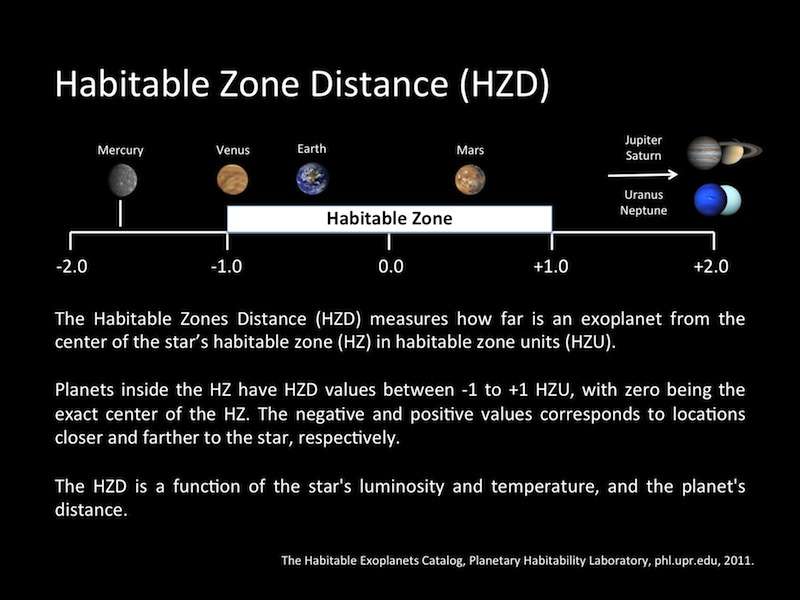
2- Earth Similarity Index (ESI)
The ESI or the "easy scale," measures how similar are planets to Earth in a scale from zero to one, with one being identical to Earth [4]. ESI values between 0.8 and 1.0 correspond to Earth-like planets with a rocky composition that is able to hold a terrestrial atmosphere under temperate conditions. The ESI is a function of the planet's radius, density, escape velocity, and surface temperature.

3- Standard Primary Habitability (SPH)
The SPH measures the thermal-water climate suitability of a planet for land primary producers (vegetation) in a scale from zero to one, with one being more habitable [5]. It is correlated with the global distribution of vegetation and net primary productivity (NPP). The SPH is a function of surface temperature and relative humidity. Only the thermal component of the SPH is used for exoplanets, assuming that water is present.
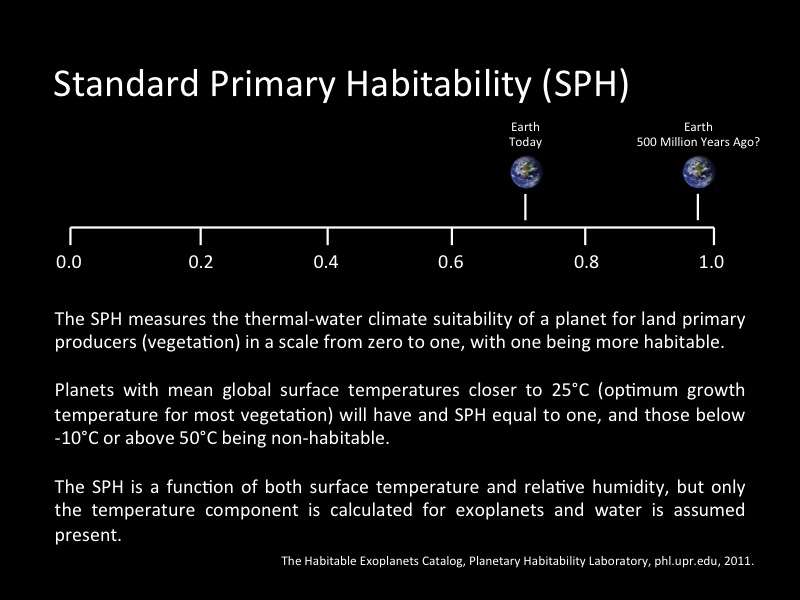
There are also other criteria, whereas there are not as important as the three exposed above and haven't be used for the graphical database results, there are nonetheless interesting to know:
References
[1] Muirhead P. S. et al. (2011) ApJ (submitted).
[2] Borucki W. J. et al. ApJ 736 19 (2011)
[3] Méndez A. et al. (2012) The Habitable Exoplanets Catalog (in preparation).
[4] Schulze-Makuch D. et al. (2011) Astrobiology (in press).
[5] Méndez A. (2010) AbSciCon 2010, 5483-5484.
--------------------------------------------------------------------------------------------------------
The Graphical Database Results
The following images list the only four confirmed exoplanets so far that are potentially habitable. They are listed from best to worst by similarity to Earth using the Earth Similarity Index (ESI). Earth and Mars are also listed for comparison. All of them are "warm" planets because they orbit their parent star in the habitable zone, the region where liquid water is possible (HZD between -1 and +1).
The habitability metrics used here only considered the possibility for surface life, as we know it, and not any potential subsurface life, hence Europa, Titan, and Enceladus are not included in the Solar System planets list. The image representations of the planets are to scale. Numbers in red are estimated values from planetary theory and are subject to large variations.
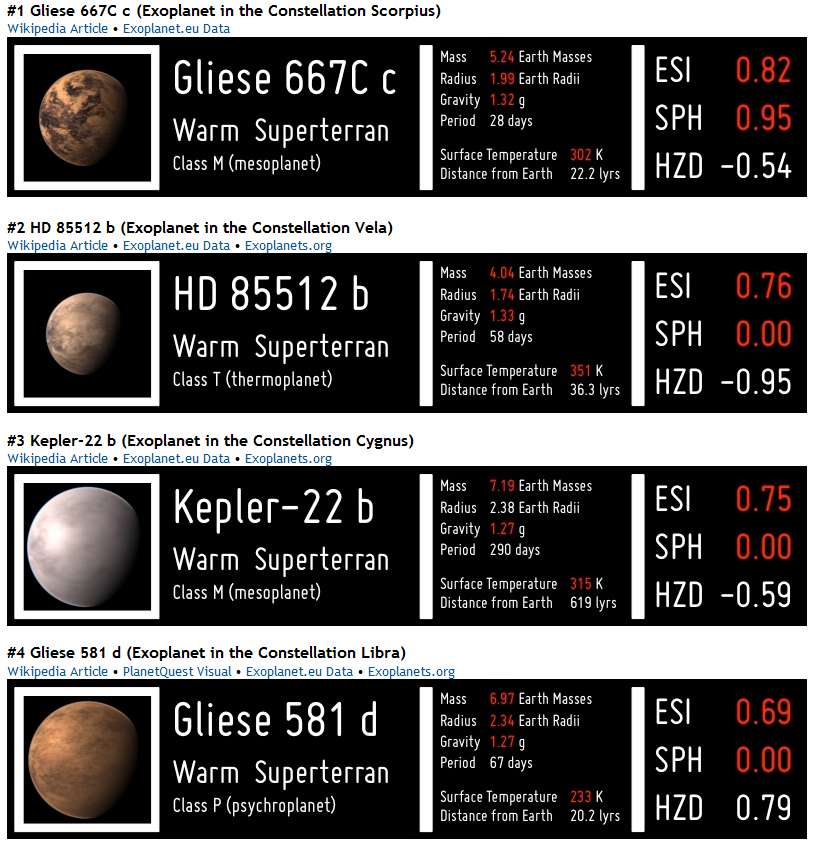
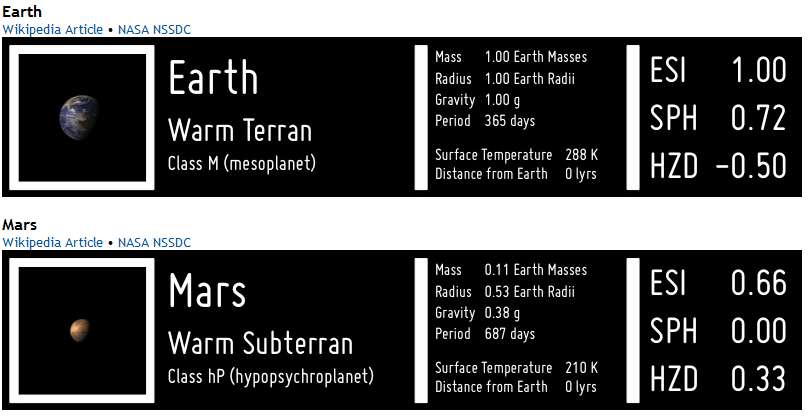

To be continued for the sources.....]
Here's the last update of the Habitable Exoplanets Catalog Project from the Planetary Habitability Laboratory
This page display graphical results of the analysis performed as part of the Habitable Exoplanets Catalog (HEC). It identifies and rank potential habitable exoplanets from both confirmed and unconfirmed exoplanets.
Before presenting the whole results, let me explain shortly what are the three major criteria needed for the calculations of the hability of a given exoplanet:
1- Habitable Zones Distance (HZD)
The HZD is a measure of how far a planet is from the center of its parent star habitable zone (HZ) in habitable zone units (HZU) [3]. Planets inside the HZ have HZD values between -1 to +1 HZU, with zero being the exact center of the HZ. The negative and positive values correspond to locations closer and farther to the star, respectively. The HZD is a function of the star’s luminosity and temperature, and the planet’s distance.

2- Earth Similarity Index (ESI)
The ESI or the "easy scale," measures how similar are planets to Earth in a scale from zero to one, with one being identical to Earth [4]. ESI values between 0.8 and 1.0 correspond to Earth-like planets with a rocky composition that is able to hold a terrestrial atmosphere under temperate conditions. The ESI is a function of the planet's radius, density, escape velocity, and surface temperature.

3- Standard Primary Habitability (SPH)
The SPH measures the thermal-water climate suitability of a planet for land primary producers (vegetation) in a scale from zero to one, with one being more habitable [5]. It is correlated with the global distribution of vegetation and net primary productivity (NPP). The SPH is a function of surface temperature and relative humidity. Only the thermal component of the SPH is used for exoplanets, assuming that water is present.

There are also other criteria, whereas there are not as important as the three exposed above and haven't be used for the graphical database results, there are nonetheless interesting to know:
Planetary Class (pClass)
The pClass classifies planetary bodies with a combination of three thermal zones and seven mass categories. The thermal zones are hot, warm, and cold. They are related to the orbital position of the body with respect to the HZ, warm being the HZ. The mass divisions are asteroidan, mercurian, subterran, terran, superterran, neptunian, and jovian. The classification can be used for any solar and extrasolar planets including moons.
Habitable Class (hClass)
The hClass is a classification only for habitable worlds (terrestrial planets inside the HZ) in five thermal categories. The categories are hypopsychroplanets (Class hP), psychroplanets (Class P), mesoplanets (Class M), thermoplanets (Class T), and hyperthermoplanets (Class hT). These names where inspired by the names used in microbiology to describe the growth temperatures of microbial life. Class M planets also have the thermal surface requirements to support complex life (0-50°C), a name familiar from science fiction. The other categories represent conditions only habitable by extremophilic life. The generic Class NH is used for non habitable planets.
Habitable Zone Composition (HZC)
The Habitable Zone Composition (HZC) measures how compatible for life is the bulk composition of an exoplanet [3]. HZC values between -1 and +1 have a habitable composition with an iron-rock-water mix. Values below -1 correspond to unlikely high dense iron bodies (i.e. a core from a dead gas giant). Those above +1 correspond to gassy bodies like Uranus, Neptune, Jupiter, and Saturn. HZC values closer to zero are generally better candidates for a habitable bulk composition. The HZC is a function of the planet's mass and radius.
Habitable Zone Atmosphere (HZA)
The Habitable Zone Atmosphere (HZA) is a measure of the potential of an exoplanet to hold a habitable atmosphere [3]. Values between -1 and +1 have the capacity to thermally hold an atmosphere with basic ingredients for life, such as carbon dioxide, oxygen, nitrogen, water vapor, ammonia, and methane. Values below -1 correspond to bodies with thin or without atmospheres. Those above +1 correspond to probably dense atmospheres composed mainly of hydrogen and helium. HZA values closer to zero are not necessarily better. The HZA is a function of the planet's mass, radius, distance, and the star’s luminosity.
References
[1] Muirhead P. S. et al. (2011) ApJ (submitted).
[2] Borucki W. J. et al. ApJ 736 19 (2011)
[3] Méndez A. et al. (2012) The Habitable Exoplanets Catalog (in preparation).
[4] Schulze-Makuch D. et al. (2011) Astrobiology (in press).
[5] Méndez A. (2010) AbSciCon 2010, 5483-5484.
--------------------------------------------------------------------------------------------------------
The Graphical Database Results
The following images list the only four confirmed exoplanets so far that are potentially habitable. They are listed from best to worst by similarity to Earth using the Earth Similarity Index (ESI). Earth and Mars are also listed for comparison. All of them are "warm" planets because they orbit their parent star in the habitable zone, the region where liquid water is possible (HZD between -1 and +1).
The habitability metrics used here only considered the possibility for surface life, as we know it, and not any potential subsurface life, hence Europa, Titan, and Enceladus are not included in the Solar System planets list. The image representations of the planets are to scale. Numbers in red are estimated values from planetary theory and are subject to large variations.


Current Potential Habitable Worlds including both Confirmed and Unconfirmed Exoplanets
These images will be updated soon to include new objects and to separate confirmed and unconfirmed exoplanets for clarity. There are now 4 confirmed and 23 unconfirmed potential habitable exoplanets.
The following image shows a composition of all the current potential habitable exoplanets in the catalog including both confirmed and unconfirmed ones. The exoplanets are ranked by similarity to Earth from best to worst, #1 being the best candidate. The only two confirmed exoplanets in the data, HD 85512 b and Gliese 581 d, still rank very low as compared to the NASA Kepler candidates, that are waiting confirmation. All planets are shown to scale with Earth, Venus, Mars, and Mercury included for comparison (lower right). The visualization of each exoplanet was computer generated as our best interpretation of their possible appearance by the Scientific Exoplanets Renderer (SER).

To be continued for the sources.....]
edit on 10-2-2012 by elevenaugust because: Resizing pictures!
SOURCES:
1- Methods used
2- Graphical Database Results
Note that Gliese 667Cc is very close to the Earth and that there are also in the unconfirmed exoplanets at least 8 that have approximately the same size as these of the Earth...
Exciting times, isn't it?
1- Methods used
2- Graphical Database Results
Note that Gliese 667Cc is very close to the Earth and that there are also in the unconfirmed exoplanets at least 8 that have approximately the same size as these of the Earth...
Exciting times, isn't it?
This is just an outstanding thread. Not just the topic but the way it was presented. I love to read about this kind of stuff. Just amazing to know
that somewhere there is another Earth. We will find it someday, I just hope that I am here when they do.
Reminds of the series Battle Star Gallactica where they are on their search for the "fabled" Earth. When they find it they are in just complete aww.
Reminds of the series Battle Star Gallactica where they are on their search for the "fabled" Earth. When they find it they are in just complete aww.
edit on 10-2-2012 by HawkeyeNation because: (no reason given)
Great thread.
I realize we have no method yet of finding information on moons of gas giant exoplanets, but I suspect that it would be possible for a Jupiter-type gas giant to exist within the habitable zone of its star and have Earth-like moons orbiting it.
I realize we have no method yet of finding information on moons of gas giant exoplanets, but I suspect that it would be possible for a Jupiter-type gas giant to exist within the habitable zone of its star and have Earth-like moons orbiting it.
edit on 2/10/2012 by Soylent Green Is People because: (no reason given)
Originally posted by Soylent Green Is People
Great thread.
I realize we have no method yet of finding information on moons of gas giant exoplanets, but I suspect that it would be possible for a Jupiter-type gas giant to exist within the habitable zone of its star and have Earth-like moons orbiting it.
It would be possible for a Jupiter-type gas giant to exist OUTSIDE the habitable zone of its star and have Earth-like moons.
Life there could be very different than here on earth, but also very possible.
reply to post by Illustronic
I was thinking along the lines of earth-like moons of a gas giant existing within the habitable zone because their parent gas-giant exists within the habitable zone -- even if the gas-giant is not considered to be "earth-like".
I was thinking along the lines of earth-like moons of a gas giant existing within the habitable zone because their parent gas-giant exists within the habitable zone -- even if the gas-giant is not considered to be "earth-like".
This is an interesting thread OP and I am in no way trying to knock either it or your interest in habitable planets outside our solar system, but I am
going to knock the entire idea of searching for habitable planets in general.
I find it kind of asinine, that we are spending so much time, brain power, energy and resources to identify habitable planets in other solar systems and little to no, of the aforementioned to full scale exploration, colonization and utilization of the recourse in our OWN solar system. Seeing as the former offers little to no value to the human race, since we don't even have the ships and systems to effectively move about our solar system, let alone the advanced propulsion systems that would be required to ever reach any of these distant habitable planets.
Oh well I guess the scientists should take the data and carve the coordinates on a stone tablet, then after the human race perishes in an ELE, because we are to stupid to actually work together and get off this planet, then at least what ever form of future sentient life arises on the earth will know what habitable planets are out there for them to explore.
Sorry for venting on your thread, but every time I see scientists searching for habitable planets it makes my blood boil. Anyway, cool thread and a flag for you.
I find it kind of asinine, that we are spending so much time, brain power, energy and resources to identify habitable planets in other solar systems and little to no, of the aforementioned to full scale exploration, colonization and utilization of the recourse in our OWN solar system. Seeing as the former offers little to no value to the human race, since we don't even have the ships and systems to effectively move about our solar system, let alone the advanced propulsion systems that would be required to ever reach any of these distant habitable planets.
Oh well I guess the scientists should take the data and carve the coordinates on a stone tablet, then after the human race perishes in an ELE, because we are to stupid to actually work together and get off this planet, then at least what ever form of future sentient life arises on the earth will know what habitable planets are out there for them to explore.
Sorry for venting on your thread, but every time I see scientists searching for habitable planets it makes my blood boil. Anyway, cool thread and a flag for you.
edit on 10-2-2012 by prisoneronashipoffools because: typo
edit on 10-2-2012 by prisoneronashipoffools because: typo
reply to post by Soylent Green Is People
I was thinking of of a Jupiter-like planet creating a habitable zone for a moon even if the Jupiter-like planet is outside of it's stars habitable zone. We might discover life on such a moon yet in our own solar system orbiting the original Jupiter. Tidal heating, molecular exoatmospheric exchange, extended magnetosphere, could be some factors possible.
I was thinking of of a Jupiter-like planet creating a habitable zone for a moon even if the Jupiter-like planet is outside of it's stars habitable zone. We might discover life on such a moon yet in our own solar system orbiting the original Jupiter. Tidal heating, molecular exoatmospheric exchange, extended magnetosphere, could be some factors possible.
I have been educated, errrr well you have certainly done your best, What a great thread. Well illustrated with charts and graphs.
Originally posted by Soylent Green Is People
Great thread.
I realize we have no method yet of finding information on moons of gas giant exoplanets, but I suspect that it would be possible for a Jupiter-type gas giant to exist within the habitable zone of its star and have Earth-like moons orbiting it.
edit on 2/10/2012 by Soylent Green Is People because: (no reason given)
Took the words right out of my mouth... With the recent info talking about water on the moon of Jupiter, it does make one wonder if the dynamics between a gas giant and a moon aren't completely understood. Would a gas giant be able to reflect enough sun light onto the moon? Would the gravitational tugging be enough to keep the core of the moon in a constant state of friction to generate enough heat to keep rock molten / moon warm enough for liquid water to form close to the surface, shielded from ice at the outer layers?
and yeah, im not versed in this area as my observations above prove lol..
reply to post by Xcathdra
It sounds like you are asking about what "illustroinic" was saying. I agree that it may be possible for the gas giant to aid in creating a habitable moon, but I was only talking about a Gas Giant in the habitable zone of a star with potential earth-like moons.
What I'm saying is that we should not ignore gas giants that lie in a star's habitable zone just because they do not have rocky surfaces like the earth. Even though those gas giants are not rocky worlds they could have moons that are rocky like the earth.
It sounds like you are asking about what "illustroinic" was saying. I agree that it may be possible for the gas giant to aid in creating a habitable moon, but I was only talking about a Gas Giant in the habitable zone of a star with potential earth-like moons.
What I'm saying is that we should not ignore gas giants that lie in a star's habitable zone just because they do not have rocky surfaces like the earth. Even though those gas giants are not rocky worlds they could have moons that are rocky like the earth.
edit on 2/10/2012 by Soylent Green Is People because: (no reason given)
Stop making these awesome threads elevenaugust! Your making the rest of us look slack!
I believe I mentioned in your other thread, that if this stuff excites any fellow ATS'ers, jump on the Planet Hunters webpage where you actually get to trawl through real Kepler data and find potential exoplanets. The chance to do this is such a wonderful gift! You even get to be listed as a co-finder of the possible planets! (not name them though, well officially anyway).
As for the 'Goldilocks Zone', the tech to best-guess on data from these potentials is astounding really. We'll never truly know yet for many many years. But these 'possibilities' are needed to inject real dreams and aspirations in the next generation of scientists.
(Also, ATS needs to padlock you here for safe keeping!)
I believe I mentioned in your other thread, that if this stuff excites any fellow ATS'ers, jump on the Planet Hunters webpage where you actually get to trawl through real Kepler data and find potential exoplanets. The chance to do this is such a wonderful gift! You even get to be listed as a co-finder of the possible planets! (not name them though, well officially anyway).
As for the 'Goldilocks Zone', the tech to best-guess on data from these potentials is astounding really. We'll never truly know yet for many many years. But these 'possibilities' are needed to inject real dreams and aspirations in the next generation of scientists.
(Also, ATS needs to padlock you here for safe keeping!)
Originally posted by Illustronic
reply to post by Soylent Green Is People
I was thinking of of a Jupiter-like planet creating a habitable zone for a moon even if the Jupiter-like planet is outside of it's stars habitable zone. We might discover life on such a moon yet in our own solar system orbiting the original Jupiter. Tidal heating, molecular exoatmospheric exchange, extended magnetosphere, could be some factors possible.
SciFi author Larry Niven had the same idea with his book, "World Out Of Time":
Warning! The wiki link below will tell you about the book enough to where you might be "spoiled" if you have never read it, but want to
en.wikipedia.org...
Don't want to say too much as it could spoil people, but imagine this: Our sun is a red giant, but the Earth has been moved to orbit Jupiter.
Niven published the book in 1976, before we understood a lot more about Jupiter than we do now. Still, I thought it was a cool read when I read it back in 1981.
S&F to the OP, good post!
reply to post by Soylent Green Is People
I believe I completely understand your point now. Since planets are still very hard to confirm, moons around planets are still near impossible to confirm. I think what you are saying is that even though we find a gas giant in a habitable zone of a star, we should not discount the possibility that undetected moons around the gas giant couldn't harbor conditions for 'earth-like' conditions.
The search is for as similar in mass to earth terrestrial bodies and gas giants may not be looked at closely enough. But from what I read some of the gas giants are quite volatile and bizarre, extremely hot and violent rotations. If we are to detect terrestrial earth sized bodies on their own I believe earth sized moons would also become apparent, so maybe they aren't totally discounting earth-like moons, I just don't think there are many gas giants in stable gentile proximity to their stars so far discovered.
I believe I completely understand your point now. Since planets are still very hard to confirm, moons around planets are still near impossible to confirm. I think what you are saying is that even though we find a gas giant in a habitable zone of a star, we should not discount the possibility that undetected moons around the gas giant couldn't harbor conditions for 'earth-like' conditions.
The search is for as similar in mass to earth terrestrial bodies and gas giants may not be looked at closely enough. But from what I read some of the gas giants are quite volatile and bizarre, extremely hot and violent rotations. If we are to detect terrestrial earth sized bodies on their own I believe earth sized moons would also become apparent, so maybe they aren't totally discounting earth-like moons, I just don't think there are many gas giants in stable gentile proximity to their stars so far discovered.
reply to post by Illustronic
Yes. Maybe I wasn't as clear in my first post. A lot of people are ignoring the gas giants that lie in the habitable zone simply because they are gas giants. However, it is possible those gas giants could harbor a moon that is a lot like Earth -- or at least harbor a moon that has all the things life needs to flourish.
However, your point is valid, too. A gas giant NOT in the habitable zone (something like our Jupiter) could possibly have moons that -- due to the peculiarities associated with the gas giant, such as gravitational tidal forces -- could create a moon where life could potentially exist (something like Europa, with its possible warm oceans).
Yes. Maybe I wasn't as clear in my first post. A lot of people are ignoring the gas giants that lie in the habitable zone simply because they are gas giants. However, it is possible those gas giants could harbor a moon that is a lot like Earth -- or at least harbor a moon that has all the things life needs to flourish.
However, your point is valid, too. A gas giant NOT in the habitable zone (something like our Jupiter) could possibly have moons that -- due to the peculiarities associated with the gas giant, such as gravitational tidal forces -- could create a moon where life could potentially exist (something like Europa, with its possible warm oceans).
Originally posted by Soylent Green Is People
I was thinking along the lines of earth-like moons of a gas giant existing within the habitable zone because their parent gas-giant exists within the habitable zone -- even if the gas-giant is not considered to be "earth-like".
As i understand it that would be unlike as according to our current theories on solar formation the sun will either draw off all the gaseous matter on the proto-planets or from the protoplanetary disk that close or, when the sun's fusion reaction starts, 'blow' of what is left. Well something like that...
en.wikipedia.org...
Or even more interestingly,
metaresearch.org...
Stellar
Great post OP
GJ 667Cc seems to be the number one candidate so for. What's more is that even though it has 4.5 times the mass of the earth, it's gravity is only 1.32G, so a 100 lb man would only weigh 132 lbs, not 450 lbs.
This is explained as follows:
blogs.discovermagazine.com...
Also the temperature is 302K which is about 84F or 29C. Water would be in a liquid state, if any existed there. Since we are finding gaseous, frozen or liquid water almost everywhere, there is a high probability of water being there also.
GJ 667Cc definitely seems to be one place to send a probe to.
GJ 667Cc seems to be the number one candidate so for. What's more is that even though it has 4.5 times the mass of the earth, it's gravity is only 1.32G, so a 100 lb man would only weigh 132 lbs, not 450 lbs.
This is explained as follows:
The gravity you feel standing on the surface of a planet does depend on its mass — double the mass and you double the gravity — but it also depends on the inverse square of its size. So if you keep it the same mass but double the radius, the gravity drops by a factor of 4. So if GJ 667Cc has 4.5 times the Earth’s mass, but is twice as big, the gravity on the surface could be quite close to ours.
blogs.discovermagazine.com...
Also the temperature is 302K which is about 84F or 29C. Water would be in a liquid state, if any existed there. Since we are finding gaseous, frozen or liquid water almost everywhere, there is a high probability of water being there also.
GJ 667Cc definitely seems to be one place to send a probe to.
new topics
-
Shane Gillis commercial
Jokes, Puns, & Pranks: 2 minutes ago -
Elon Says It’s ‘Likely’ He Buys Tanking MSNBC
Political Ideology: 2 hours ago -
Montelukast affects brain, caused 5 year old to attempt suicide
Medical Issues & Conspiracies: 3 hours ago -
Jaguar Rebrand Video Causes "WTF?" Moment - Seriously Weird
Automotive Discussion: 5 hours ago -
Let's start a conspiracy
General Conspiracies: 5 hours ago -
What Joe Rogan said Vs The View
Dissecting Disinformation: 8 hours ago -
Biden's "Reckless" Decision To Escalate Russia-Ukraine War
World War Three: 9 hours ago
top topics
-
Biden's "Reckless" Decision To Escalate Russia-Ukraine War
World War Three: 9 hours ago, 16 flags -
Jaguar Rebrand Video Causes "WTF?" Moment - Seriously Weird
Automotive Discussion: 5 hours ago, 13 flags -
What Joe Rogan said Vs The View
Dissecting Disinformation: 8 hours ago, 11 flags -
Montelukast affects brain, caused 5 year old to attempt suicide
Medical Issues & Conspiracies: 3 hours ago, 9 flags -
Elon Says It’s ‘Likely’ He Buys Tanking MSNBC
Political Ideology: 2 hours ago, 9 flags -
Inca stone masonry at Sacsayhuaman, Ollantaytambo and the Sun Temple
Ancient & Lost Civilizations: 17 hours ago, 7 flags -
Let's start a conspiracy
General Conspiracies: 5 hours ago, 1 flags -
Shane Gillis commercial
Jokes, Puns, & Pranks: 2 minutes ago, 0 flags
active topics
-
Elon Says It’s ‘Likely’ He Buys Tanking MSNBC
Political Ideology • 42 • : CarlLaFong -
Biden's "Reckless" Decision To Escalate Russia-Ukraine War
World War Three • 109 • : Oldcarpy2 -
Shane Gillis commercial
Jokes, Puns, & Pranks • 0 • : theatreboy -
Well we know Putins ICBMs won't fail in their silos
World War Three • 168 • : NoCorruptionAllowed -
What Joe Rogan said Vs The View
Dissecting Disinformation • 18 • : bluesman023 -
Jaguar Rebrand Video Causes "WTF?" Moment - Seriously Weird
Automotive Discussion • 14 • : bluesman023 -
A Mysterious Orb filmed over NYC by local news
Aliens and UFOs • 22 • : lostgirl -
FEMA Head Admits Agency Skipped 20 Homes with Trump Signs
Mainstream News • 19 • : NorthOS -
Gaetz withdraws from attorney general consideration
US Political Madness • 25 • : bluesman023 -
Is Russia Using a New Type of Beam Weapon Against Ukraine?
Weaponry • 21 • : Ravenwatcher
27

